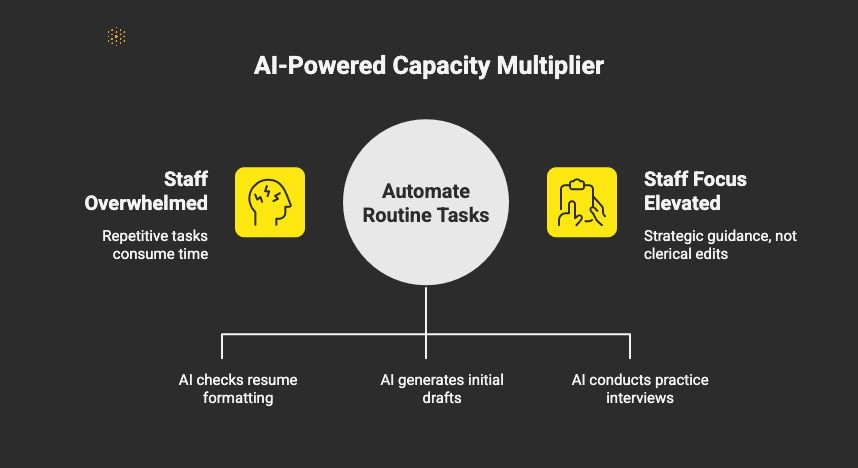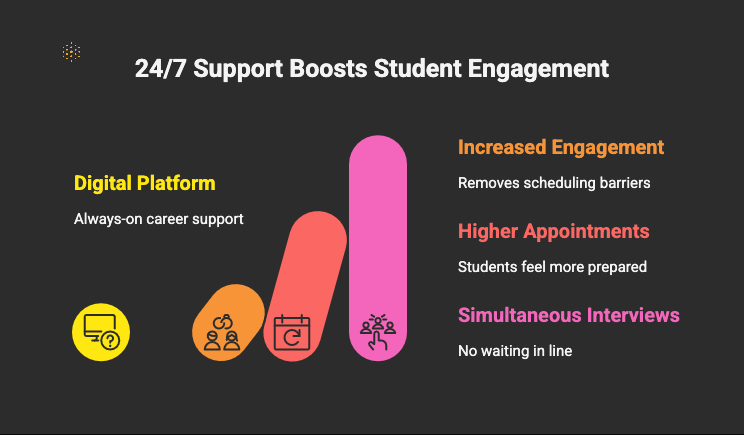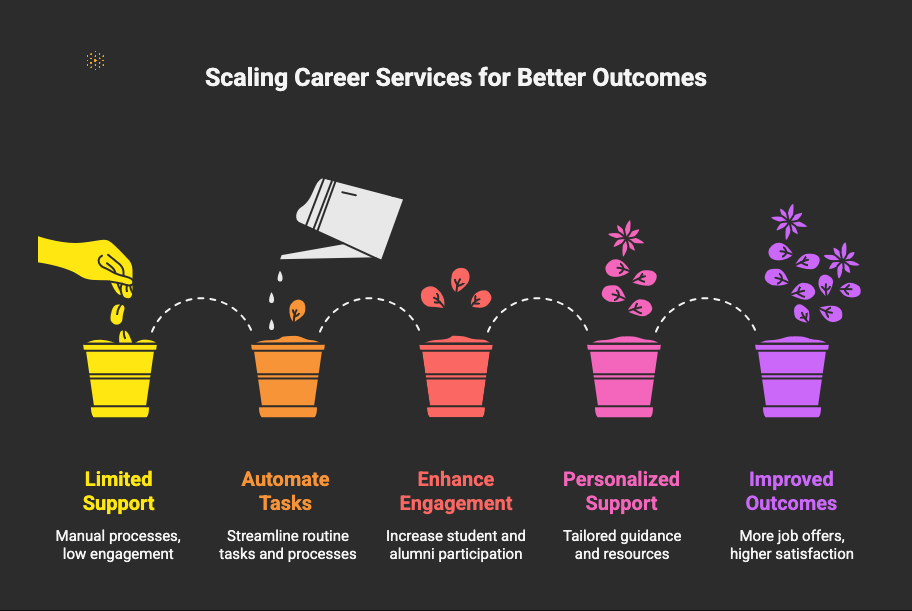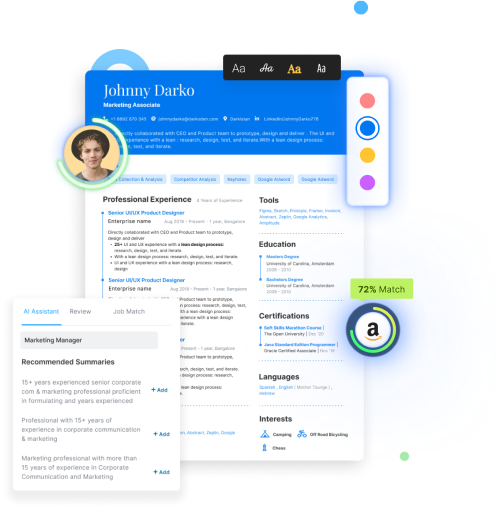How can small career services teams scale their impact without hiring more staff?
Adopt a smarter system that pairs streamlined processes with AI to automate routine tasks, enable 24/7 self-serve support, and surface analytics. Staff then focus on higher-value coaching, making small teams scalable.
Colleges often assume the only way to expand career services is by hiring more staff.
But headcount alone can’t solve the structural problem: too many students, too many repetitive tasks, and not enough bandwidth for meaningful guidance.
The real breakthrough comes from rethinking operations - aligning process and technology so your existing team can do more, faster, and at higher quality.
A smarter system turns routine work into automated workflows and frees counselors to focus where they add the most value.
So what does rethinking operations actually look like? It starts with 3 key multipliers.
The “Smarter System” Advantage: Three Key Multipliers
Investing in a smarter career services system - think AI-driven resume review platforms, chatbots for career Q&A, virtual mock interviews, and unified student engagement dashboards, yields exponential benefits.
Rather than linear gains, technology can create multipliers that amplify your team’s impact in three critical areas: capacity, engagement, and outcomes.
1. Capacity Multiplier: Do More With the Same Team
A smarter system acts as a capacity multiplier, taking over repetitive or preliminary tasks so that each staff member’s bandwidth goes much further.
Consider how much time career advisors traditionally spend on routine activities: proofreading resumes for format issues, giving the same 101 advice on cover letters, conducting basic mock interviews, answering common questions like “how do I find internships?”.
Automating these first-draft and first-touch tasks can save dozens of hours per staff member per month.
In practice, this means AI tools handle the grunt work, checking resume formatting, suggesting keyword improvements, generating initial cover letter drafts, or conducting an AI-driven mock interview, and then advisors step in for higher-level coaching.
At Tech Elevator, counselors were able to cut resume review time from weeks to a day or two, because the AI had already ensured a student’s draft met basic standards before a human ever looked at it.
Shawnee State’s team saved 40+ hours in one semester’s pilot just on mock interviews by letting students practice in an AI platform before any one-on-one meeting.
Crucially, this capacity boost isn’t about replacing staff, it’s about elevating staff to do what humans do best.
By shifting 100% of your focus from clerical edits to strategic guidance, a small team can service far more students without burnout.
In short, the AI handles the volume; your staff handles the value.
This multiplier effect makes a team of 3 perform like a team of 6, or a team of 6 like a team of 12.

Also Read: How does counselor burnout reveal a career center system that’s no longer working?
2. Engagement Multiplier: 24/7 Support, No Waiting in Line
Another game-changing benefit of a smart system is the engagement multiplier.
Traditional career services operate mostly 9-to-5 and often require students to book appointments or wait for feedback.
That model simply doesn’t match the rhythms of modern students. A digital platform, however, can be available 24/7, giving students immediate access to help whenever motivation strikes - be it midnight resume tweaks or a Sunday afternoon interview practice.
This “always on” support dramatically increases student engagement by removing barriers of scheduling and availability.
For example, students at Shawnee State gained round-the-clock access to career prep tools - and the data showed they used it outside business hours, since it was there when they needed it.
The result was not only more convenience, but also more students coming in for higher-value appointments (a 6% rise in appointment volume) because the easy questions were answered and students felt more prepared.
This immediacy keeps students engaged, they don’t have to email a resume and wait days for a review; they get pointers on the spot.
The engagement multiplier also means no more waiting in line for help.
Imagine being able to conduct 30 mock interviews simultaneously in a class lab session, instead of spending an entire week doing them one by one.
That’s exactly what Shawnee State achieved: “students were each in their own space… completing their mock interviews simultaneously through Hiration. Previously, these interviews would’ve been one-on-one… This approach allowed us to offer a similar experience in a fraction of the time,” said Dr. Raines.
No student had to wait or be turned away due to overbooking.
By meeting students where they are - online, on their schedule, a smarter system dramatically increases usage.
More engagement means more students building skills and confidence, which in turn means better outcomes.
Also Read: How is Hiration better than Big Interview?

3. Outcome Multiplier: Better Results and Proof of Value
Ultimately, the goal of scaling career services is better student outcomes - more students landing good jobs or internships, and doing so faster and with greater confidence.
A smarter system can be a powerful outcome multiplier by improving the quality of support and tracking the metrics that matter.
When routine tasks are automated and engagement increases, counselors can devote attention to truly transformational interventions (like career planning, personal branding, networking connections), and students show up to interviews far more prepared.
The data bears this out:
- A recent analysis by NACE found that graduates who used their college career center services received more job offers on average than those who didn’t. Class of 2022 grads who used even one career service had 1.24 job offers on average (and each additional service used nudged that higher), versus just 1.00 offers for those who never engaged. More engagement = more offers.
- Improving the quality of career support dramatically boosts student and alumni satisfaction. Gallup surveys reveal that graduates who rated their career services experience as “very helpful” were 5.8× more likely to strongly agree their education prepared them for life after college, and 3.4× more likely to recommend their alma mater to others. The unfortunate flip side is that only 8% of grads actually both used career services and found them very helpful - meaning there is huge room to lift outcomes by making services more effective for more students. A smarter system is a key part of that effectiveness, ensuring consistent, high-quality guidance at scale.
- Tech Elevator’s career platform not only saved time; it directly led to more students getting shortlisted for interviews and offers as their resumes and interview skills improved. Students reached the interview stage 60% faster than before. And MUST Ministries achieved what can only be described as an outcomes breakthrough - a 93% jump in total job placements and a 147% increase in combined wages earned by their clients after integrating Hiration.

In essence, by scaling personalized support, a smarter system helps each student or job-seeker achieve stronger results.
And it provides the data to prove it.
Platforms like Hiration include dashboards and analytics (e.g. how many resumes created, improvements in resume scores, mock interview performance, etc.), which allow career centers to demonstrate ROI to administrators and funders.
In short, better outcomes justify the budget - even if you didn’t hire more staff to achieve them.
Also Read: What are the top 5 career services benchmarks every center must track?
The ROI: Calculating the Payoff of a Smarter System
It’s important to translate these improvements into the language of resource allocation - time and money.
What does “saving time” really mean for your team’s capacity and your institution’s bottom line?
Let’s do a sample calculation:
Imagine a career center with 4 full-time counselors. Each counselor currently spends, say, 15 hours a week on repetitive tasks like basic resume reviews, formatting edits, and answering FAQs via email.
If an AI-driven system takes over those 15 hours for each person, that’s 15 hours × 4 staff = 60 staff hours freed up per week.
Over the course of a school year (~40 weeks of active counseling), that’s 2,400 hours annually that can be repurposed to higher-impact work.
To put it in perspective, 2,400 hours is roughly equivalent to 1.25 full-time employees (assuming ~1,920 work hours per year is one FTE).
In other words, the existing team of 4 gains the output of an additional staff member for free. This is capacity you’ve essentially “hired” via technology.
In budget terms, if a typical counselor’s fully loaded salary is, say, $60,000, then 1.25 FTE of value equates to $75,000 in work hours.
Even if the AI platform costs a fraction of that, you’re looking at a significant return on investment (ROI) in pure labor value alone.
And this doesn’t even count the qualitative ROI of improved student outcomes (which, as noted, ties to institutional goals like retention, alumni donations, and rankings).
By investing in a smarter system, career centers essentially buy time - the most precious resource, at a discount, and convert it into better service for students.
Also Read: Why are career services using outdated career tools?
Wrapping Up
When routine work is automated, students stay engaged around the clock, and outcomes are tracked with hard data, your center becomes both more efficient and more impactful.
That’s exactly what we’ve built at Hiration.
From AI-powered resume reviews to virtual mock interviews and student engagement dashboards, our platform helps career teams save time, serve more students, and deliver stronger results, without burning out staff or stretching budgets.
Want to see how this could work for your center? Schedule a live walkthrough tailored to your students and staff.
Frequently Asked Questions
-
What are the three multipliers that scale a career services team?
You scale through three multipliers: capacity, engagement, and outcomes. You align process and technology so your team does more, faster, at higher quality.
-
How does a smarter system increase capacity for a small team?
You automate first-draft and first-touch tasks to save dozens of hours per staff member per month. The AI handles the volume; your staff handles the value.
-
How does 24/7 support improve student engagement?
You provide help that is available 24/7, removing scheduling barriers and boosting usage. At Shawnee State, this led to a 6% rise in appointment volume.
-
What outcomes improve when you adopt a smarter career services system?
Students reach the interview stage 60% faster, and more get shortlisted and offers. Some programs saw a 93% jump in total job placements and a 147% increase in combined wages earned.
-
How do you calculate ROI for a smarter system?
Multiply hours saved per counselor by staff count and weeks. For example, 15 hours × 4 staff = 60 hours per week, 2,400 hours annually, about 1.25 full-time employees, worth $75,000 at a $60,000 salary.
-
Which career services tasks should you automate first?
Start with routine work: proofreading resumes, cover letter basics, basic mock interviews, and common FAQs. Then use AI for checking resume formatting, suggesting keyword improvements, generating initial cover letter drafts, and conducting an AI-driven mock interview.
-
How does a smarter system eliminate wait times for mock interviews?
You run mock interviews simultaneously instead of one by one. For example, you can conduct 30 mock interviews simultaneously in a class lab session, so there is no more waiting in line for help.
-
How does a smarter system change the role of advisors?
You shift 100% of your focus from clerical edits to strategic guidance. Advisors coach at a higher level while AI handles the grunt work and first-touch tasks.
-
How does rethinking operations differ from hiring more staff?
You fix the structural problem instead of adding headcount. Aligning process and technology lets your existing team do more, faster, and at higher quality.
-
How do dashboards and analytics help you prove value?
You track resumes, scores, and mock interview performance in dashboards and analytics. These metrics allow you to demonstrate ROI to administrators and funders.



